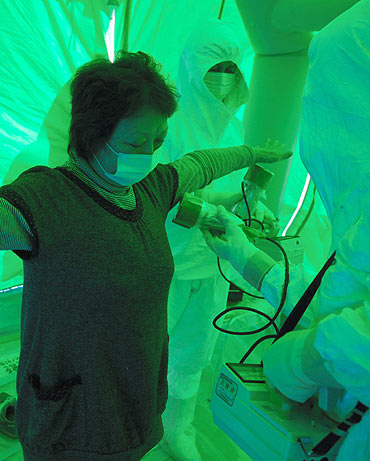This article was first published 14 years ago
Home »
News » Explained: The Fukushima crisis and lessons for India
Explained: The Fukushima crisis and lessons for India
Last updated on: March 17, 2011 08:50 IST
Image: The No 3 nuclear reactor of the Fukushima Daiichi nuclear plant is seen burning after a blast
Photographs: Reuters
The reactors that exploded at the Fukushima nuclear plant in Japan following the earthquake and tsunami are similar to those at Maharashtra's Tarapur atomic power plant. But does India need to worry? The answer is twofold -- yes and no. While circumstances to be anticipated in India may be very different with no likelihood of earthquakes or tsunami of a similar magnitude, steps need to be taken to review the safety of nuclear plants, writes LV Krishnan, former director, safety research and health physics group at Indira Gandhi Centre for Atomic Research, Kalpakkam.
Resistance to earthquakes is a primary requirement for reactor designers in Japan and the country have so far been quite successful in meeting it. In an earthquake in July 2007, a large cluster of reactors in Japan, of the same type as in Fukushima, all remained unscathed though the site was close to the epicenter and the intensity at the site was larger than anticipated by design.
Therefore, news of the earthquake in Japan on March 11 did not, at first, cause too much alarm in Japan's nuclear power circles. But, in the time since March 11, the situation at Fukushima not far from the epicenter has gradually gone from bad to worse.
All the six reactors in Fukushima are Boiling Water Reactors, quite similar to the reactors back home at Tarapur in Maharashtra and were built at about the same time -- over 40 years ago. There should therefore be particular interest in India to follow the events in the reactors at Fukushima.
However, there is not much authentic information coming in from government sources in Japan for a proper analysis of the cause and course of the events. This is in total contrast to the United States action following the partial core meltdown at Three Mile Island in 1979 when hour-by-hour reports were sent out to all countries with American designed reactors including India.
...
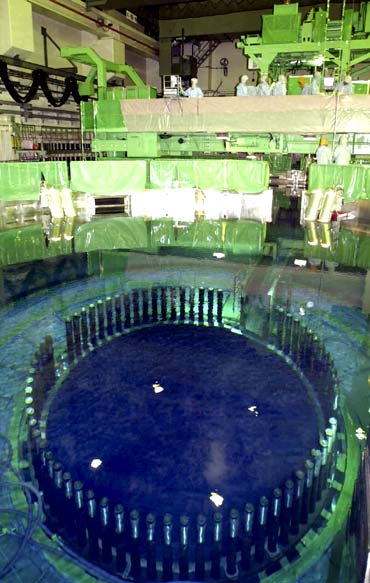
Image: The inside of reactor No 4 is seen at the Fukushima Daiichi nuclear plant
Photographs: Yomiuri Shimbun/Reuters
We can at best piece together reports about the developments in Fukushima site available from different sources. The similarity in design with the Tarapur BWRs is of some help.
First, some general observations. The plant structures at Fukushima appear to have withstood well the impact of the 8.9 magnitude earthquake, though they were designed for an anticipated one of 7.9 and of the tsunami that came later. All of the several hundred staff working at the plant was safe. The plant safety systems acted in time to shutdown the operating reactors.
The emergency diesel sets began providing needed power supply. They were, however, disabled after an hour by the tsunami of unprecedented power that followed the earthquake. The batteries kept the instruments operational for several hours. When they were drained there was nothing much the plant staff could do. There was no chance of revival of either power source for quite sometime.
From the events at the plant that followed it would seem that the situation faced by the struggling operating staff had not figured in the emergency operating procedures. They have had to pay urgent attention to several new problems in many reactors simultaneously. But they have continued to grapple with the challenges valiantly and deserve our sympathy and praise.
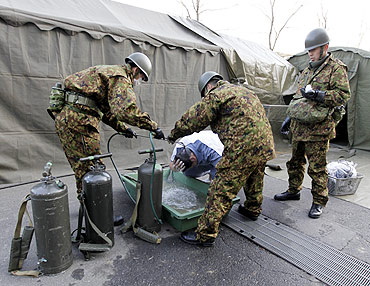
Image: A man who was evacuated from the vicinity of Fukushima's nuclear power plant washes his head at Japan Ground Self-Defense Forces makeshift facility to cleanse people who might have been exposed to radiation
Photographs: Yuriko Nakao/Reuters
In these reactors, the primary containment consists of a carbon steel structure known as dry well. It has the shape of a round-bottomed flask with a long neck as used in chemistry laboratories.
The reactor vessel is housed within the neck region of this structure. Below it are the pumps used to circulate water within the reactor. The lower part of the primary containment is connected to a torus around it containing a large amount of water. The torus is part of the primary containment and is called the wet well.
In the box-type structures that we see in Fukushima, the lower part of the structure houses the primary containment. The upper part houses the spent fuel storage pool. Reports from Japan refer to this upper part as the secondary containment.
In the event of a leak of the high-pressure coolant water from the reactor vessel into the dry well, it would turn into steam. But, the steam would find its way into the torus and condense thereby limiting any pressure rise in the primary containment.
The design provides multiple ways of injecting water into the reactor vessel in the event of a leak. If this is unsuccessful as happened in the Fukushima reactors, fuel temperature rises. The fuel is sealed in a tube of zirconium alloy. As the tube heats up, zirconium reacts with the water in the vessel and hydrogen is produced.
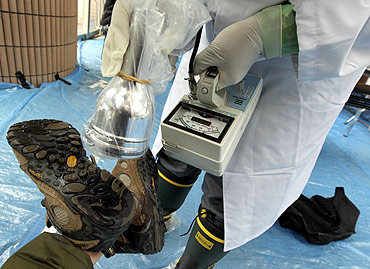
Image: Medical staff screen the boots of a person who is concerned over radiation exposure at a public welfare center in Niigata, northern Japan
Photographs: Yuriko Nakao/Reuters
In the Tarapur reactors, any hydrogen so released in an accident would be diverted to a large empty chamber. As hydrogen spreads in it, the concentration would fall and an explosion is averted by the dilution.
Filling the chamber with nitrogen to avoid an explosion was another option in the design. Hydrogen entry into the upper part of the reactor building is not anticipated at Tarapur. Nevertheless, this upper part of the building at Tarapur is a strong concrete structure.
In all the reactor buildings in Fukushima, the upper part appears to be of a design very different from the Tarapur reactors. It is apparently designed intentionally to yield easily in the event of a hydrogen explosion. The pictures of the damaged building with only the steel shell remaining would seem to confirm it.
We also see the entire roof blown off. It is not clear if this has left the spent fuel storage pool open to sky. If so, that would be a matter of great concern. The aerial photographs do not provide a clear indication.

Image: Japan Self-Defense Force officers prepare for a clean-up at a radiation affected area in Nihonmatsu, Fukushima
Photographs: Kyodo/Reuters
Very likely the hydrogen explosion in the reactor building and the consequent impact on equipment and instrumentation in that part of the plant area have rendered extremely difficult further damage control operations in the Fukushima reactors.
All power plants maintain a large supply of fresh water for use in an emergency. It would seem that the tsunami had brought with it a lot of debris and fouled up the available supply. That and the fact that four of the reactors needed fresh water supplies badly and simultaneously was presumably the reason to resort to the pumping of seawater into the reactor vessel for cooling purpose.
This step is unprecedented and rules out the possibility of restart of the reactors. It is also likely to pose problems later in waste management operations.
Image: Medical staff use a Geiger counter to screen a woman for possible radiation exposure at a public welfare centre in Hitachi City
Photographs: Asahi Shimbun/Reuters
At this time, the situation in Fukushima is still evolving. Unfortunately, the challenges are growing in enormity with further explosions. Some fuel melting within the reactor vessel is also not being ruled out. It had happened before in the Three Mile Island accident but with no environmental consequences. There now appears to be some uncertainty about the integrity of the reactor vessel in one of the reactors.
Radiation levels are reported to have risen high but have returned to much lower levels. Radioactive contamination of some of the population near the plant site has been reported. With sensitive instruments now available, it is possible to detect the presence of radioactive substances even at very low levels that are of no particular significance.
Most of the radioactive material released so far from the Fukushima reactors is likely to consist of gaseous and volatile substances that would be dispersed fairly quickly. Chernobyl on the contrary experienced a sudden explosion in the very heart of the reactor core and a fire of graphite in the core that continued to spew radioactive material including the fuel particles into the atmosphere. Comparison of Fukushima with Chernobyl can therefore be only figurative.
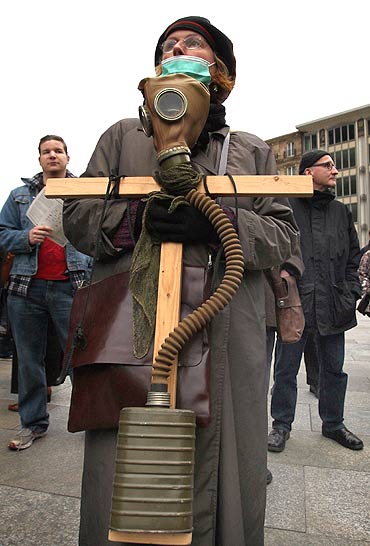
Image: An activist holds a sign referring to the nuclear disaster at the Fukushima facility in Japan during an anti-nuclear demonstration
Photographs: Christof Koepsel/Getty Images
The prompt and efficient manner in which nuclear emergency plans were implemented is praiseworthy and has some lessons for us. The plans were activated immediately after the earthquake struck. Notifications were made to the government authorities by the power plant as soon as electrical power was lost and again when there was uncertainty about adequacy of core cooling.
Instructions went out to the public to remain indoors, take iodine tablets as a prophylactic measure or be prepared to evacuate. They were followed in an orderly fashion. Arrangements were made to monitor all residents for radioactive contamination. Some of the above actions were implemented by the authorities early on, merely as a matter of precaution. This proved to be very wise since later developments did demand such steps.
It is natural that questions will now be raised in India and elsewhere about the wisdom of relying on nuclear power. While the circumstances to be anticipated in India may be very different with no likelihood of earthquakes or tsunami of similar magnitude or frequency, steps will be taken nevertheless to review the design safety features at all the plants in India drawing from the Japanese experience and to introduce enhancements wherever necessary.
This was also done in the wake of the Chernobyl accident. There are important safety features in design that distinguish the reactors we have in India and those we are planning to build from those in Fukushima. At Kudankulam too, Indian engineers did not accept the design that the Russia sold to China but insisted on several additional safety measures to be incorporated.

Image: 21 years on, a Ukrainian girl still suffers the after effects from the 1986 Chernobyl nuclear disaster
Photographs: Desmond Boylan/Reuters
The accident in 1979 in a reactor in the US at Three Mile Island and that in Chernobyl in Ukraine in 1986 were both caused by operator error. The world had managed to recover from both these two accidents and many countries have now been considering the nuclear power option as a response to threat of climate change.
The events at the Fukushima reactor site in Japan are likely to lead to a reconsideration of that option. China will also have to review the plans for building nuclear power plants in the western part of the country that is prone to earthquakes.
It must be noted that major technological hazards are not uncommon whether in chemical industry, mining or in transportation by air and sea craft. The experience is that over time, people tend to forget and technology also learns from experience. The decision to abandon a technology as a result of one bad experience also depends on the availability of alternate choices.





